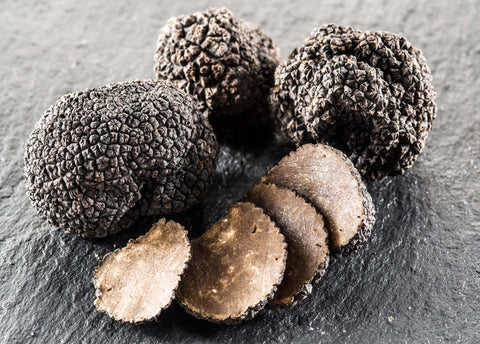truffle is the most appreciated and expensive mushroom in the world. Yes, it is a fungus, and it is also hypogeum, that is, it grows underground. This is well known, but what is perhaps not known is that the truffle is a symbiotic mushroom, meaning it necessarily lives exchanging nutrients with an arboreal plant to produce what is called the sporocarp, or the fruit body commonly called truffle.
The different species
1. Tuber Magnatum Pico
The determination of the different species of truffles is based mainly on morphological characteristics such as the shape, the size, the color of the gleba (that is, the inner part), but also on perfume and taste. To date, the species classified as Tuber are 63, of which 25 are present in Italy, but only 9 are considered edible and only 6 are the most commonly marketed.
Alba white truffle or Acqualagna or fine white

It has a globular and often irregular shape. The gleba, with numerous white veins, varies from milk-colored to pink and ocher. The dimensions can easily reach those of a large apple, but some specimens have far exceeded the kilo. It is harvested from late summer until the beginning of winter and is a spontaneous mushroom: today there are no cultivation techniques. In addition to the regions of Northern and Central Italy, it is found only in Istria.
The white truffle is the spearhead among the various species of the prized mushroom, for which the market and great chefs are often willing to pay very high figures.
3 determining factors for the price of white truffles.
The price of a white truffle depends on three fundamental factors:
- Environmental: closely connected with the territory in which this prized mushroom grows.
- Seasonal: they are linked to the climatic variations that affect the growth of the white truffle.
- Market: the price of the truffle is united in double line with the level of demand for the product.
The alternation and insistence of these 3 factors, even close to the harvest, can significantly affect the price of white truffle.
The market and the price of white truffles Tuber Magnatum Pico develops in soils that must remain fresh and moist, both during germination and maturation: this year this has not happened, making the harvest rather scarce, and making prices jump up.
But let’s not forget to always consider another factor, the market demand which is unstable and fluctuating in nature. This can significantly influence the listing.
2. Tuber Melanosporum Vitt.
Norcia black truffle or precious black

The shape is globular and the gleba is brown and black, furrowed by light and thin veins. The size can reach and even exceed that of a large apple. It is harvested throughout the winter period and in particular in the first months of the year, especially under oaks, hazels and black hornbeams. It is widespread throughout Italy but is also harvested in France and Spain.
3. Tuber Aestivum Vitt.
Scorzone

The scorzone is a black truffle, also called summer truffle, whose name comes from its characteristics as it has a rough and warty rind. It differs from others since when cut, the gleba is not dark, but tends to be dark yellow. It grows both sandy and clay soils, in the woods and the pine forests. The harvesting period begins in May, continuing until late autumn. Although it is less prized than the white truffle and the black truffle, the scorzone is widely appreciated because of its affordable price.
Cleaning and storage
Trimming the truffle is done by immersing it completely in cold water for a few minutes, then brushing it very carefully using a soft brush under running water to remove sand and earth residues. Before serving, it must be allowed to dry completely. Regarding conservation, there are traditionally two methods: closed in a glass jar dipped in rice or wrapped in a paper towel to be changed daily. Preserve in the refrigerator at a temperature between 2 and 4 ° C. This can last about 8 days while maintaining its qualities. Remember that it must be consumed as soon as possible since it is an extremely delicate product and subject to mass loss.
Buying guide
If you have decided to give yourself one of these jewels of nature note that sometimes you pass off species of truffles that are not very valuable. It is advisable to dwell on the visual, tactile and olfactory aspect before buying, following some the following rules:
When you touch it, it should be hard (a sign of freshness) and slightly elastic. On the contrary, a truffle that squashes between the fingers probably hides rottenness or it is, however, a damaged piece.
It is difficult to identify the smell by checking the aromatic smell that characterizes the quality of this product to discover among the various best sample. Taking into consideration the Tuber Magnatum Pico, it is perfect if the nose releases a balance between garlic, hay, and honey and to be discarded if only a penetrating ammoniacal note is perceived.
As for the price, it is entirely advisable to expect that the truffles are carefully weighed before your eyes and that they meet the average market prices for the year.



Post A Comment (0)